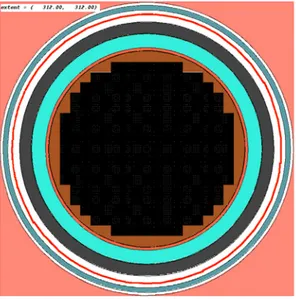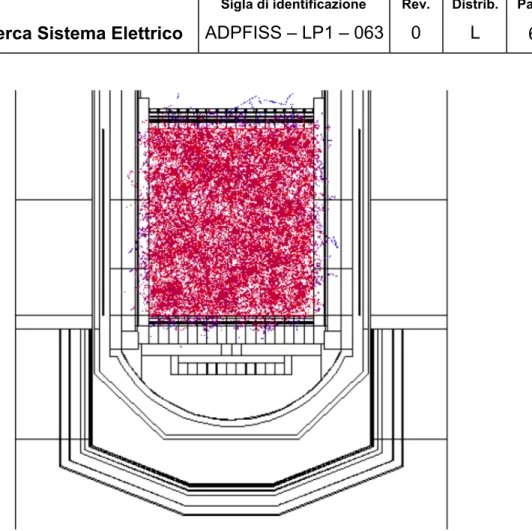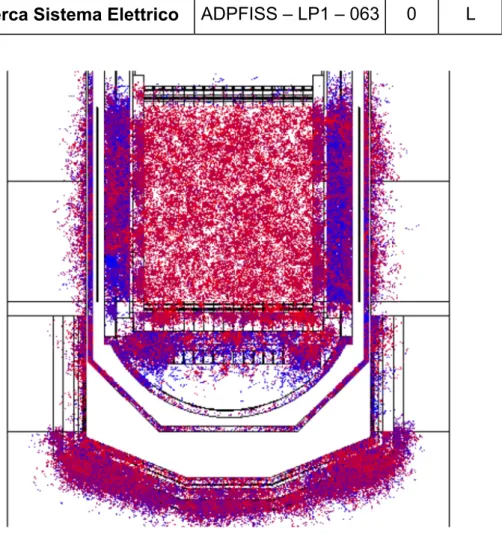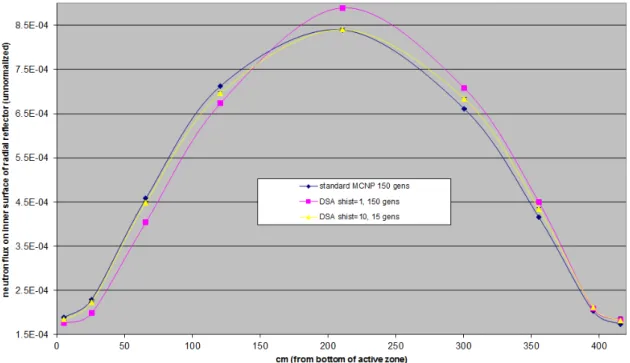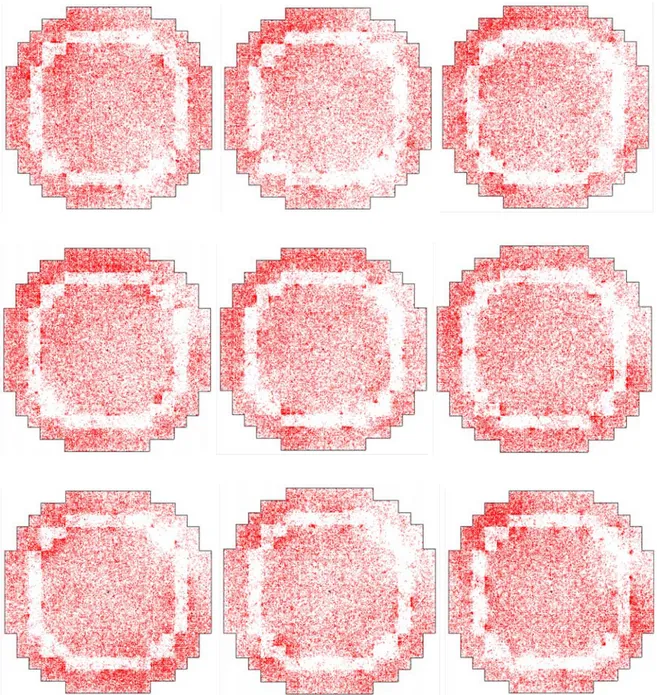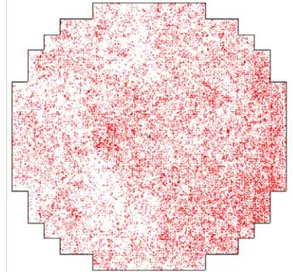Introduction
The general framework of this activity is support to IRSN in safety evaluations in PWR’s. It is worthwhile briefly to put the activity in the period Oct. 2014 – Sept. 2015 in context:
The first collaboration covering approximately two years dealt with the change in the signal in ex-core neutron detectors in the pressure vessel (PV) well when a conventional reflector consisting of a relatively thin steel baffle with water outside is replaced by a thick steel reflector. The second collaboration covering approximately 1 year dealt with the effect on the phenomenon of flux tilting of this same replacement of a conventional reflector by a thick steel reflector. Both these activities have been documented in PAR reports of previous years. The current activity concerns the estimation of the radiation fluxes and doses experienced by various instrumentation placed around the PV and in the concrete in the PV well. The purpose of this instrumentation is to detect the position of corium in a severe accident scenario. It has also been previously reported in PAR.
The ENEA input to these activities involved its experience with running Monte Carlo simulations, in particular when the attenuation is substantial (i.e. “deep penetration”) and variance reduction (VR) techniques need to be employed. In-house VR techniques for radiation transport with Monte Carlo have been developed at ENEA Bologna since the middle 1980’s and such development is ongoing. The current activity differs somewhat from the two previous collaborations in that these Monte Carlo developments play a more important role.
MCNP5 (ver. 1.4) [1] and MCNP6 [2] have been employed, either in their standard, distributed, form or patched with the in-house VR parameter generator for fixed source [3] or for eigenvalue [4],[5],[6] problems. It should be mentioned that in the first collaboration (ex-core neutron detectors) and in the current activity, both MCNP5 and MCNP6 have been patched in order to read a pin-by-pin fission source in a PWR reactor core with a certain axial binning and in the case of MCNP5 in order to identify the cells in which response-contributing gamma’s are created from neutron interactions.
Actions
The decoupled calculation
The “classic” approach of decoupling the calculation, the first part being the eigenvalue calculation in the core that generates the fundamental mode of fission sites, and the second part being the fixed source calculation outside the core with the various neutron and gamma responses (employing variance reduction), was adopted as the “work horse” methodology to generate all the requested responses. This is the approach generally (actually to the authors’ knowledge, exclusively) employed. The point of decoupling varies: it can be the fission sites in the core or it can also be the radiation leakage from the core. Here we use the fission sites in the core as this brings the advantage of eliminating the angular and energy variables – the emitted fission neutrons are isotropic with a fission energy spectrum that can be described well analytically – leaving only the spatial variables – x, y and z – to be treated. (However it should be mentioned that for MOX fuel, or when higher actinides are present after burnup, there is a probability of fission neutrons being emitted from a nucleus that is not 235U. Such neutrons have a slightly different energy spectrum compared with 235U, especially in the high energy tail which may be important for neutron leakage from the PV.) The spatial variables were treated by defining a certain number of axial bins (typically 35-40) and treating each individual fuel pin separately (but assuming a homogeneous source radially within each fuel pin). The standard version of MCNP does not cover such a source, thus the code had to be patched as already mentioned.
The first part of the decoupled calculation – the eigenvalue calculation – involved the usual issues of reaching the fundamental mode of fission sites in a large thermal reactor core, starting from a pointwise neutron source. Such issues have been discussed in the documentation of the first and second collaborations with IRSN.
A radial section of the core is shown in Fig. 1 and an axial section in Fig. 2. In this calculation, the 45° symmetry that is present was exploited. To tally the fission
source in all the radial/axial bins, due to both memory and slow-down issues, six separate calculations were made, each calculation tallying different pins and assemblies. Each calculation ran, starting from the same fundamental mode source, 4000 fission generations, each of 400000 fission neutrons. Thus the tracking in each of the six calculations was identical.
Fig. 1: Radial section of core up to the pressure vessel well
Then a stand-alone code interface was employed to read each of the six “mctal” files [1], and write the fission sites in a format to be read by the patched MCNP employed in the second part of the calculation. Here the 45° symmetry was abandoned and a 360° azimuthal model was employed in the second part of the decoupled calculation. It may be mentioned here that it has been found convenient to format the fission sites in both sequential and direct access files to aid the speed of reading and sampling in the second part of the calculation.
In the second part of the decoupled calculation, the fissions were switched off and, employing the patched code to read the source, VR parameters were generated for all the requested responses simultaneously. However the neutron and gamma ray responses were generated separately as experience has shown that, although it is possible to generate VR parameters that are good for both neutron and gamma ray responses, the separate parameters are quite different and it is often faster to run two separate calculations: neutron-only for the neutron responses and n-gamma for the gamma ray responses. This is what was done. The multi-response capability, documented in [3] and in references cited therein, was key to allow all the responses to be included in each, deep penetration calculation.
To demonstrate the need for variance reduction in this calculation, Fig. 3 shows the fission source and neutron collision events in a 20 cm thick slice either side of the x-z plane without variance reduction whilst Fig. 4 shows the fission source and
neutron collision events in the same slice with the optimized VR parameters found with the algorithm documented in [3]. (The red dots represent higher energy and the blue dots lower energy.) In these two figures, approximately the same number of source fission neutrons are plotted. We see clearly that without variance reduction, hardly any neutrons exit the upper or lower plena regions, or the barrel (situated just outside the heavy steel radial reflector). Instead with optimized VR parameters, the neutrons not only exit these regions but also populate over the whole energy range of interest the sacrificial concrete at the bottom of the PV well. Note in Fig. 4 the neutron collisions of course have very different weights so that the responses remain
Fig. 3: Second part of decoupled calculation: source fission events and neutron collisions in a 20 cm thick slice with no variance reduction
In this way, a set of optimized VR parameters was created for neutrons and separately for neutrons and gamma rays, and then employed to generate neutron fluxes and spectra and gamma ray fluxes, spectra and doses at various positions where instruments will be situated within the pressure vessel well and at various depths within and below the sacrificial concrete in the bottom of the well.
This phase of the activity lasted from the provision of the first results in early December 2014 to the final results in early March, 2015. The criterion of “convergence” of the Monte Carlo results was the usual one in design work that the statistical error be negligible compared to model uncertainties and data uncertainties. Some further calculations were made to analyse the system in the light of the results already obtained. Variations on the basic model were: a 239Pu fission spectrum as source; a homogenous fission source in the core (for comparison purposes with results obtained at IRSN).
Fig. 4: Second part of decoupled calculation: source fission events and neutron collisions in a 20 cm thick slice with optimized variance reduction
In the transport model electrons were not transported but assumed to deposit their energy locally (the “kerma” approximation). As some of the instrumentation has dimensions comparable to or smaller than the electron range, ancillary calculations were made to estimate the effect of the kerma approximation. If such instrumentation is on the surface of the sacrificial concrete, the real gamma dose is lower by 25-40% compared with the kerma approximation dose. Within the sacrificial concrete, the real and kerma doses should be comparable. Instead in contact with the ZrO2 insulator, the real dose should be slightly higher than the kerma approximation.
Supplementary calculations were made:
- for the instrumentation positions in and near the sacrificial concrete, an analysis of where the gamma’s that provide most of the dose originate. It turns out that most of the dose is due to gamma’s born locally in the sacrificial concrete itself.
(As previously mentioned, these calculations were made with an in-house MCNP5-1.4 patch.)
- the water content in the steel reflector (that model the coolant channels) was raised by 1%. This produced negligible change to the responses.
- an analysis was made to try to understand the differences in gamma spectra in the sacrificial concrete between IRSN (employing ENDF/B-VII) and ENEA (employing JEFF-3.1). It turned out that 56Fe was responsible for the difference in the energy range 7-8 MeV and 54Fe for the difference in the range 8-10 MeV.
In early May 2015, following a supplementary request, results were supplied for the neutron and gamma ray fluxes to the lower (thinner) part of the pressure vessel.
The part of this work that is not classified will be published as a joint IRSN-ENEA report that will include more extensive results.
The coupled calculation
Following the above analysis of the problem using the “classical” decoupled approach (an eigenvalue calculation writing the fission sites that are spatially binned followed by a fixed source calculation reading the fission source), in April 2015 a campaign started to generate the same results employing a single eigenvalue calculation, following: [4],[5],[6].
The advantages of the single calculation are:
1) avoidance of the in-house patch that reads the pin-by-pin source, each pin with its own axial distribution (at least until such a source is included as a standard). The patch reduces the quality control.
2) avoidance of the necessity of binning the source, axially and radially. The radial binning is currently at the pin level, not within each pin. This is not conservative. Instead the axial binning should be conservative.
3) Avoidance of the need to specify a single analytic fission distribution (235U for the standard run).
Thus it is hoped that the above approximations can be properly quantified by comparing the results of the single calculation and the decoupled approach. However the disadvantage of the single calculation is that the fundamental mode is poorer
than that calculated in a decoupled calculation because a) less calculational effort is made to estimate it compared with the decoupled calculation and b) the variance reduction employed in the single, coupled calculation damages slightly the fundamental mode whilst the decoupled calculation runs analogue in the first, eigenvalue, part. As is now being extensively documented (see for example [7],[8]), an incompletely calculated fundamental mode is very often not reflected in the estimated errors in the results.
This calculation is ongoing. A first attempt to generate the requested neutron and gamma ray responses resulted in appreciable differences between the results of the single calculation and the decoupled approach. However such differences turned out to reflect a poor fundamental mode in the case of the single calculation rather than the approximations 2) and 3) above. This can be illustrated by considering the axial distribution of the neutron leakage from the fissile zone (i.e. at the inner surface of the heavy reflector – see Figs. 1 and 2). Fig. 5 shows three axial distributions. The first (“standard MCNP 150 gens”) is calculated with standard MCNP with, starting from the fundamental mode, 150 fission generations each with 350000 fission neutrons, and with no variance reduction. This distribution subsequently changed little after 10 times the number of generations were run and is considered near the correct one. The distributions: “DSA shist=1, 150 gens” and “DSA shist=10, 15 gens” were generated with the patch discussed in [4],[5],[6] and included optimized VR parameters to calculate all the neutron responses outside the core. [The first distribution employed 150 superhistories (see [4]) each with 350000 fission neutrons and the second distribution employed 15 superhistories each with 350000 fission neutrons. The first distribution employed a superhistory of 1 fission generation and the second distribution employed a superhistory of 10 fission generations.] The errors on each calculation point [one standard deviation as calculated by MCNP between fission source particles per generation (standard MCNP) or per superhistory (DSA patch)] are present in Fig. 5 but are mainly masked by the data points. We see clearly, in particular in the case of the distribution “DSA shist=1, 150 gens”, a large underestimation of the error.
Fig. 5: Demonstration of variance reduction producing a distortion that is not picked up by the error estimation
Fig. 6a: Fission sites in a radial slice of the core in one fission generation
without variance reduction
Fig. 6b: Fission sites in a radial slice of the core in another fission generation
without variance reduction
The question of the distortion to the fundamental mode can be further demonstrated by considering the radial distribution of fission sites in various eigenvalue
fission sites in a radial slice of the core without variance reduction for two different fission generations. These distributions look quite smooth without “clumping” or “coagulation” (see [7]).
Fig. 7: Fission sites in a radial slice of the core in nine successive fission generations with unacceptable variance reduction (1/100 Russian roulette survival probability in
the the 3rd-from-outer assembly ring)
Next we show a case already discussed in [4] (§6.2.4: “test case I”) in which a Russian roulette survival probability of 1/100 was imposed on the lower energy groups in the 3rd-from-outer assembly ring. This variance reduction was shown in [4]
to produce unacceptable distortions in the fundamental mode. In Fig. 7 are shown the fission sites in a radial slice of the core with this variance reduction for a sequence of nine fission generations, each one following on from the previous one (reading left to right, then down page).
Finally in Figs. 8a and 8b are shown the fission sites in the same radial slice of the core for two different fission generations for the example taken from [4], §6.4, of optimized VR parameters for a neutron response outside the core in the East direction (an ex-core neutron detector in the PV well). We see in Figs. 8a and 8b a certain inhomogeneity of the fission sites that may be acceptable as far as the result of the ex-core detector is concerned if a sufficient number of fission generations are run.
This problem has aspects in common with the current activity of the estimation of the radiation fluxes and doses experienced by various instrumentation placed around the PV and in the concrete in the PV well. An important difference is that in the current activity azimuthal symmetry is assumed. The inhomogeneities exhibited radially in Figs. 8 seem to be appearing axially, as shown in Fig. 5.
Fig. 8a: Fission sites in a radial slice of the core in one fission generation with
VR parameters that are optimized to an ex-core response in the East
direction
Fig. 8b: Fission sites in a radial slice of the core in another fission generation with VR parameters that are optimized
to an ex-core response in the East direction
Concluding, for the single, coupled, calculation to provide correct error estimates of the ex-core responses and therefore allow the approximations in the results obtained with the decoupled approach to be properly evaluated, a check such as that shown in Fig. 5 must be made to ensure a sufficient number of fission generations have been run. It must be emphasized that, to the authors’ knowledge, the single, coupled, approach is innovative.
Concluding remarks
The decoupled approach with the patch to read the pin-by-pin fission source and the DSA VR patch in the second, fixed source, part of the calculation has
performed satisfactorily. All the requested neutron and gamma responses have been generated with a small statistical error.
The innovative, single-calculation approach is currently being tested on this problem. Current indications are that the fundamental mode must be verified with an analogue calculation to ensure that the error estimates on the ex-core responses are correct.
Acknowledgement
This activity was performed in close collaboration with M. Brovchenko and I. Duhamel of the Institut de Radioprotection et de Sûreté Nucléaire.
References
[1] X-5 Monte Carlo Team “MCNP – A General Monte Carlo N-Particle Transport Code, Version 5”, Vol. I: Overview and Theory. LA-UR-03-1987; Vol. II: User’s Guide. LA-CP-03-0245; Vol. III: Developer’s Guide, LA-CP-03-0284, Los Alamos National Laboratory (2005)
[2] Denise B. Pelowitz (Ed.) “MCNP6TM User’s Manual - Version 1.0”, LA-CP-13-00634, Rev.0 (May 2013)
[3] Burn, K.W. “Optimizing Monte Carlo to Multiple Responses: the Direct Statistical Approach, 10 Years On”, Nucl. Technol. 175, 138-145 (2011)
[4] Burn, K.W. “Optimizing variance reduction in Monte Carlo eigenvalue calculations that employ the source iteration approach”, Ann. Nucl. Energy, 73, 218-240 (2014)
[5] Burn, K.W. “Estimating Local In- and Ex-Core Responses within Monte Carlo Source Iteration Eigenvalue Calculations”, Proc. of PHYSOR-2014, Kyoto and JAEA-Conf 2014-003 (2014)
[6] Burn, K.W. “A correction and a clarification to ‘Optimizing variance reduction in Monte Carlo eigenvalue calculations that employ the source iteration approach’”, Ann. Nucl. Energy 85, 776 (2015)
[7] Dumonteil E. et al. “Particle Clustering in Monte Carlo Criticality Simulations”, Ann. Nucl. Energy, 63, 612-618 (2014)
[8] Yamamoto A., Nakamura R. “Examination of pin-by-pin fission rate distribution in large geometry evaluated by the Monte-Carlo method” , Ann. Nucl. Energy, 36, 1726-1733 (2009)
